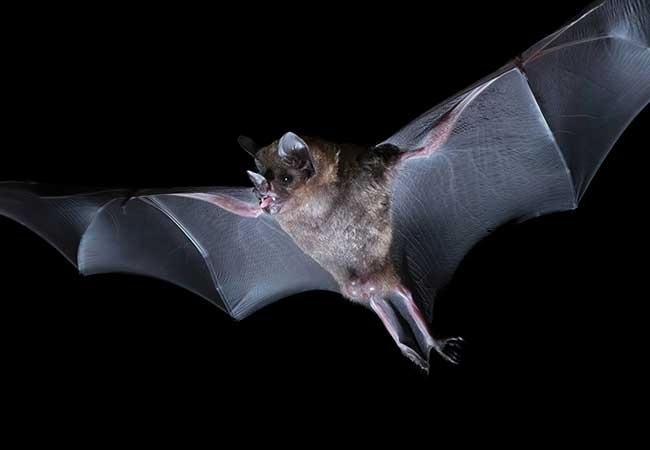Bats utilize vocalizations for both navigation and communication with their conspecifics. For the latter, they produce ultrasonic noises that reverberate and allow them to form a mental "image" of their environment.
 Seba’s short-tailed bat (Carollia perspicillata) filters out important signals from ambient sound and distinguishes between echolocation and communication calls. Image Credit: Julio Hechavarría, Goethe University Frankfurt.
Seba’s short-tailed bat (Carollia perspicillata) filters out important signals from ambient sound and distinguishes between echolocation and communication calls. Image Credit: Julio Hechavarría, Goethe University Frankfurt.
Researchers studying neurology at Goethe University Frankfurt have now figured out how the South American native Seba's short-tailed bat, or Seba, is able to separate crucial signals from background noise, particularly between echolocation and communication sounds.
Carollia perspicillata, often known as the Seba's short-tailed bat, is a species of bat found in tropical and subtropical woods in Central and South America. Its primary food source is pepper fruit. The animals live in hollow trunks and rocky caverns during the day in groups of ten to one hundred individuals, and at night they go foraging together.
They use sounds that distinguish themselves from other ambient noise in the colony, akin to the cacophony of voices during a boisterous celebration. In addition, the bats use echolocation, which produces ultrasonic noises that bounce off solid objects to help them navigate their environment. The animals then combine these echoes to create an “image” of their environment.
However, how does Seba's short-tailed bat distinguish essential noises from background noise that is always present? A popular theory holds that the brain is always anticipating the next signal and will react more forcefully to an unexpected signal than to an expected one. The term "deviance detection" refers to this process.
Researchers studying its mechanisms are neuroscientists led by Johannes Wetekam and Professor Manfred Kössl of the Neurobiology and Biosensors Working Group at the Institute of Cell Biology and Neuroscience at Goethe University Frankfurt.
In 2021, they and their associates demonstrated that signal processing starts in the brainstem, which regulates critical processes like breathing and heart rate, rather than in higher-level brain areas. These investigations, however, simply employed synthetic stimuli irrelevant to the animals.
The group led by Wetekam and Kössl replicated the experiments using echolocation calls and natural communication in a study that has just been published.
With our study, we wanted to find out what happens in deviation detection when, instead of meaningless stimuli, ones are presented to Seba’s short-tailed bat that actually occur in its auditory world.”
Johannes Wetekam, Institute of Cell Biology and Neuroscience, Goethe University Frankfurt
To capture the bats' brain waves, two electrodes, the thickness of a human hair, were placed beneath their scalps. The animals did not experience any pain during this process, but general anesthesia prevented any movement from skewing the data.
Even when the bat is unconscious and fast asleep, its brain still responds to sounds. The animals were then exposed to either communication calls or echolocation, with a 10% chance of both sounds occurring simultaneously.
From the observed brain waves, it was subsequently possible to deduce that the brainstem interprets communication calls and echolocation in a distinct way. When it came to communication noises, the likelihood of uncommon echolocation sounds happening had no bearing on the quality of the reaction, even though they did cause stronger signals than frequent ones that showed deviation detection.
Bats probably need to react faster during echolocation than when communicating with conspecifics, and the brainstem is the first station in the brain to receive the acoustic signals, which is why calculating the probability of echolocation calls might be necessary first of all there, and especially their echoes, so that the animal can dodge obstacles in good time.”
Manfred Kössl, Professor, Institute of Cell Biology and Neuroscience, Goethe University Frankfurt
Better brain synchronization is most likely the cause of the stronger response to fewer calls.
The research also shows that, in addition to pitch variations, the brainstem can identify deviations based on other characteristics of bat calls, such as abrupt changes in frequency or loudness.
This is astonishing, as the brainstem is a rather primitive part of the brain that scientists did not previously think capable of any substantial involvement in signal processing, and they saw its role more in receiving signals from the auditory nerve and transmitting them to high-level regions of the brain.”
Johannes Wetekam, Institute of Cell Biology and Neuroscience, Goethe University Frankfurt
These results may have significance for human medical applications as well. For example, while researching disorders like ADHD or schizophrenia, which are linked to poor processing of external inputs, low-level brain regions should be taken into consideration.
Understanding how the brain interprets and processes complicated human speech can also be aided by the bat brainstem interpreting complex auditory signals in different ways.
Source:
Journal reference:
Wetekam, J., et al. (2024) Deviance detection to natural stimuli in population responses of the brainstem of bats. Journal of Neuroscience. doi.org/10.1523/JNEUROSCI.1588-23.2023